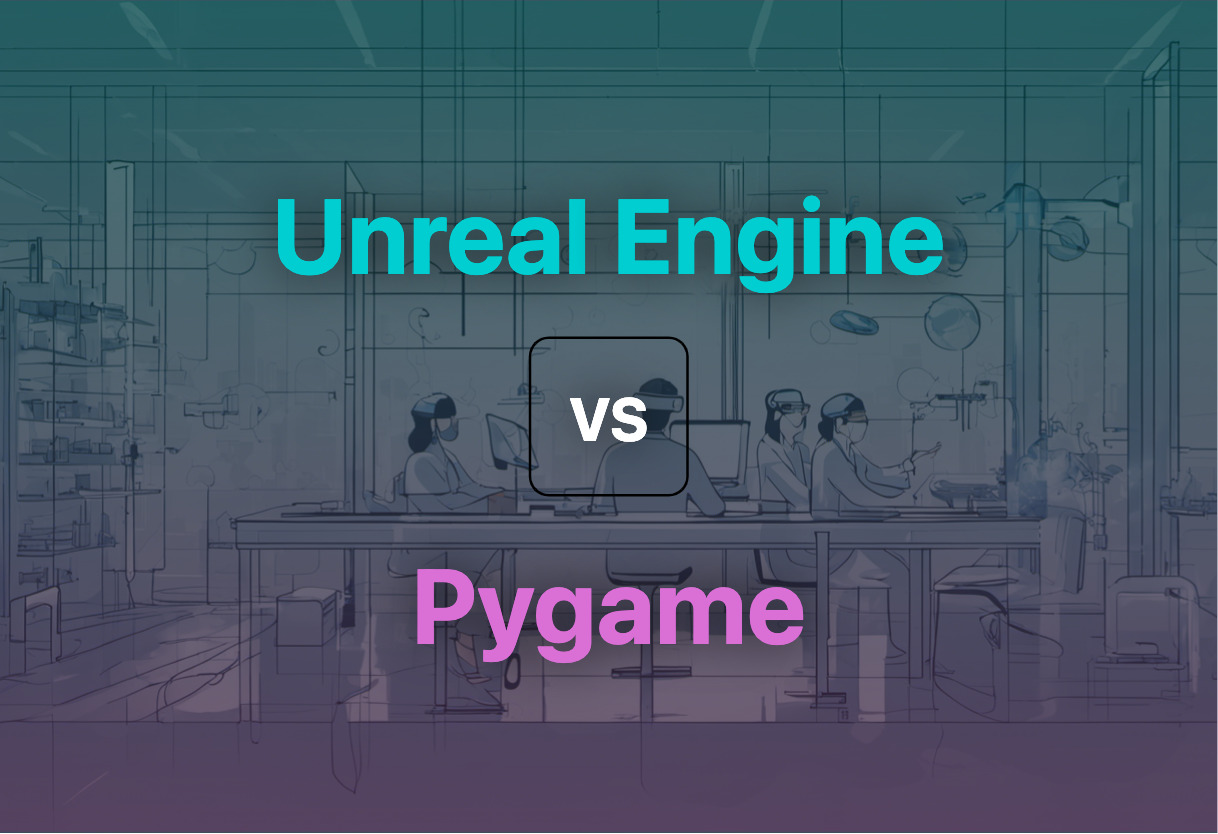For high-grade, multi-platform games, Unreal Engine reigns; harnessing the power of C++, it excels in 3D and VR, charging 5% on revenues >$1M. Conversely, Pygame is the choice for beginners; its Python-validation encourages easy game designing, focusing on 2D and MIDI. Given its GNU free licensing, Pygame is optimal for projects on a limited budget.

Key Differences Between Unreal Engine and Pygame
- Coding Language: Unreal Engine uses C++, while Pygame is based on Python, C, Cython, and Assembly.
- Focus: Unreal Engine is designed for intense 3D games and VR experiences. Pygame focuses on simplifying 2D game design and offers MIDI support.
- Cost: Unreal Engine imposes a 5% royalty on revenues above $1M. Pygame, under the GNU Lesser General Public License, is free.
- Community: Unreal Engine has a marketplace for user creations, providing 88% revenue share to creators. Pygame relies on a community-driven approach, with user-created tutorials.
| Comparison | Unreal Engine | Pygame |
|---|---|---|
| Initial Release | 1998 | October 28, 2000 |
| Latest Release | Unreal Engine 5, April 2022 | Version 2.5.0, June 2023 |
| Development Language | C++ | Python, C, Cython, Assembly |
| License Cost for Commercial Use | 5% of revenues over USD 1 million | GNU Lesser General Public License(Free) |
| Supported Platforms | Desktop, Mobile, Console, VR Platforms. | Almost every Operating System |
| Development Kit for iOS | Yes, Unreal Development Kit | No |
| Marketplace for User Creations | Yes, Revenue share of 88% for creators | No |
| Community Supported | Yes | Yes |
| Portability | High, Even for iOS | Extremely high |
| Ease of Use | Advanced, Best fit for Professionals | Great for beginners |
| Use in Education | Free for Schools and Universities | Prominently used for lessons |
What Is Unreal Engine and Who’s It For?
Unreal Engine, developed by Epic Games, garnered attention with its first PC first-person shooter, Unreal, in 1998, eventually branching out into various game genres and industries like film and TV. Written in C++, it provides broad platform support, extending from desktop and mobile to consoles and VR. Its latest iteration, Unreal Engine 5 (UE5), launched in April 2022, offers features from acquired companies such as Quixel.
The tool is perfect for game developers, modders, and content creators. It’s also widely used in schools and universities, thanks to its free availability. Incorporating a constructive solid geometry supporting level editor, UnrealEd, and simple project templates, Unreal Engine makes game development accessible.

Pros of Unreal Engine
- Wide platform support including VR.
- Game development accessible with project templates.
- Revenue sharing model for content creators.
- Free for educational institutions.
Cons of Unreal Engine
- 5% of revenues charged for commercial use over USD 1 million.
- C++ could be complex for beginners.
- Lacks customization options compared to rival engines.
What Is Pygame and Who’s It For?
Pygame is a set of Python modules designed for video game creation. Providing cross-platform capabilities, it was authorized by a passionate team of developers and released originally in 2000, with its stable release 2.5.0 as of June 2023. Built on Simple DirectMedia Layer (SDL), Pygame simplifies real-time game development and boasts a range of other functions including vector math and collision detection.
Pygame is an invaluable tool for beginners, educators, and first-time programmers due its simplicity and accessibility. Its truly portable nature allows it to run across nearly all operating systems, handheld devices, and game consoles, even OLPC computers. Notably, Pygame makes its code run faster, boosting the game’s performance.

Pros of Pygame
- Easier and more accessible for beginners.
- Highly portable and cross-platform.
- Supports faster game performance.
Cons of Pygame
- Not as powerful or versatile as some competitors.
- May struggle with larger, more complex projects.
- Community-driven development could mean slower updates and improvements.
Code Examples for Unreal Engine & Pygame
Unreal Engine
This Unreal Engine script is designed to create a basic Artificial Intelligence (AI) navigation. This script makes an AI character patrol a defined path. Ensure you have set up the AI agent and the NavMesh properly in your Unreal Engine project before you use this script.
// Declare variables
AActor* NextTarget;
// Begin path
void AAIController::PatrolPath()
{
// If path array isn't empty
if (PatrolPathArray.Num() > 0)
{
// Set the next target
NextTarget = PatrolPathArray[PatrolPathCurrentIndex];
// Move to next target (AI agent will navigate)
MoveToActor(NextTarget, 5.0f, true, true, true, 0, true);
// Get to next node in patrol path
PatrolPathCurrentIndex = PatrolPathCurrentIndex++ % PatrolPathArray.Num();
}
}
void AAIController::OnMoveCompleted(FAIRequestID RequestID, const FPathFollowingResult& Result)
{
Super::OnMoveCompleted(RequestID, Result);
// Resume patrolling
PatrolPath();
}
Pygame
The following Pygame code snippet allows for controlled movement of a sprite on the screen. Make sure you have Pygame installed on your system for the code to function correctly. Use the arrow keys to move the object.
import pygame
import sys
pygame.init()
# Create display surface
display_surface = pygame.display.set_mode((800, 400))
# Load sprite image
player_sprite = pygame.image.load('sprite.png')
# Create a rect object for the sprite
player_rect = player_sprite.get_rect()
# Game loop
while True:
for event in pygame.event.get():
if event.type == pygame.QUIT:
pygame.quit()
sys.exit()
# Get a list of all keys currently being pressed down
keys = pygame.key.get_pressed()
# If arrow key is pressed, adjust the position of the sprite
if keys[pygame.K_UP]:
player_rect.y -= 5
if keys[pygame.K_DOWN]:
player_rect.y += 5
if keys[pygame.K_LEFT]:
player_rect.x -= 5
if keys[pygame.K_RIGHT]:
player_rect.x += 5
display_surface.fill((0,0,0))
# Draw the sprite onto the surface
display_surface.blit(player_sprite, player_rect)
pygame.display.update()
Unreal Engine vs Pygame: Your Best Choice?
In the showdown between Unreal Engine and Pygame, which reigns supreme? It depends on your specific needs, skill-set, and project demands.
Advanced Developers – High Revenue Potential
If you’re an advanced developer, seasoned in C++, aiming to capitalize on high revenue potential and industry-grade game quality, Unreal Engine is your ideal choice. Notable advantages include:
- A powerful tool with its graphic prowess and vast platform support.
- Favorable royalty model for high-revenue projects.
- The robust Unreal Marketplace and advantageous revenue sharing scheme.
- Comprehensive project templates expediting development cycles.

Entry-level Developers & Educators
Are you a novice coder or an educator teaching game development? Consider Pygame. Here’s why:
- Simplified development owing to Python-based module structure
- Intuitive game speed control with adjustable FPS
- Enormous compatibility range, truly portable
- Zero-royalty model favoring non-commercial or academic purposes

Innovative Indies
Independent developers pushing the envelope with pioneering game concepts may find Pygame more fitting. This is primarily due to:
- Flexibility to develop cross-platform, shareware, freeware, and open-source games
- Inclusion in the eclectic roster of Pygame-developed games earns greater exposure
- Community-driven development approach offering continuous peer support.

If you lean towards AAA-grade visuals and high revenue potential, Unreal Engine is a no-brainer. Pygame, on the other hand, serves as a cost-effective, accessible, and versatile choice for beginners, educators, and innovative indie creators.
Hannah Stewart
Content writer @ Aircada, tech enthusiast, metaverse explorer, and coffee addict. Weaving stories in digital realms.





